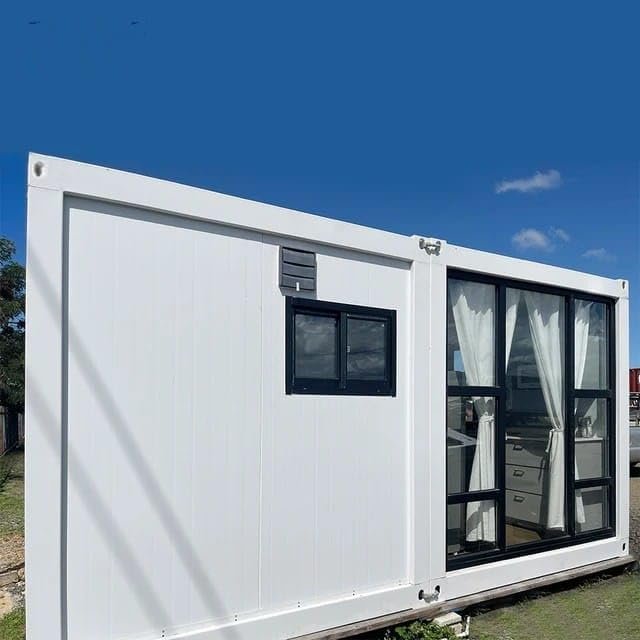
Are you worried about the durability of container homes? You’re not alone. Many prospective buyers shudder at the thought of rust, decay, and the question marks that could limit the lifespan of their investment. The idea of creating homes out of shipping containers is cool, but how long can these metal boxes really last? The line is narrow between a shipping container home which becomes a timeless sanctuary and one that becomes an old, rusty eyesore. Let’s set the record straight.
The answer to this question assumes that we can wrap our heads around the specific things that influence how long these homes survive. What if you could significantly increase the lifespan of your container home by completing several straightforward tasks? Imagine if, instead of just living in an incredible-looking house, you got to live in one that aged well and didn’t give two hoots what nature had to say about the matter?
Who’s the Boss: Let’s Get Real
Here at CubiNest, we’ve put our container homes through the wringer; we’ve sent them to developing countries all over the world, from super-humid tropics of Southeast Asia to super-hot Middle Eastern deserts.
We’ve learned something: Quality matters more than anything else.
As a manufacturer in the modular building space, we know that the longevity of your home matters a bunch. Let us share some inside information with you so that you can make better decisions for your container home.
In today’s article, we’re going to look at how things like material quality, environment, and maintenance impact the lifespan of a container home. Stay with me, and I’ll teach you about what these suckers last and some practical steps to extend it far beyond its expected years.
The Lifespan of a Container Home
There are a lot of factors that affect the lifespan of a container home such as material quality, environment, and the care it receives. Typically, homes made from new shipping containers can last for 25 - 30 years if maintained well. However, homes made from used containers may have MUCH shorter lifespans— maybe 15 years if they are not maintained.
Factors That Affect Lifespan
- Material Quality: The integrity of a container house is heavily influenced by the quality of the container it is made from. New containers, often called “one-trip” containers, have only been used once and are in excellent condition. Because of their toughness and durability, they are the best choice for creating a long-lasting container home compared to old, beat-up containers that have been beat to heck after years of riding in the deep blue sea.
- Environmental Conditions: The environment plays a big role in determining how long a container house will stand the test of time. A harsh climate including heavy rains, temperature extremes, or salt air from being near the beach can accelerate rust and decay on the exterior. Containers are extremely versatile and adaptable, but they most comfortable in a dry climate where you don’t have to deal with a lot of moisture-related issues.
- Maintenance : Just like any other structure, the key thing that will give you longevity is regular maintenance. This routine maintenance can help counteract most common problems and keep your container house in great shape. Here are a few simple maintenance activities you can do:
- Prevent Rust: Use rust-resistant paints to protect exposed metal, and frequently inspect for areas showing signs of rust.
- Keep It Clean: Keeping the exterior clean is vital to preventing moisture accumulation, which can lead to rust and corrosion.
- Proper Insulation: Proper insulation will help you control temperatures inside the house and keep condensation from forming. Otherwise, you might form rust inside the container house.
Improve the Lifespan
Through proper maintenance, protective measures, and design choices, a container home can actually outlast its projected life span. We’ve heard of some container homes being around for 40 or 50 years. The key to longevity is using high quality materials, like new containers and designing for the area of the world in which you live. Make environmental stress like extreme temperature changes or high humidity your friend.
In general, while a container home might last a typical life span of 15 to 30 years, if you are proactive with maintenance and live in the right environment, a container home can indeed be a wise, long-term investment.
Keeping the Story Going: Now, What Else Should You Know?
If you’re intrigued by the idea of a long-lasting container home, you probably want to go deeper. What are the materials you should be using? How can you make your container home last even longer than 25 years? What about common maintenance issues or the effect of climate on these homes? Keep reading, as we’re about to uncover the secrets to creating a container home that’s not only modern but resilient.
What Are the Best Materials for Rust Prevention in Container Homes?
Rust is the most prominent threat to a container home's longevity, but selecting the right materials can mitigate this problem. Anti-corrosive paints are a must for container homes. Epoxy-based coatings, for instance, are commonly used for maritime purposes and are perfect for dealing with potential rust issues in a container home.
In addition to anti-corrosive paint, the use of zinc-rich primers offers an extra layer of protection by forming a barrier that keeps oxygen and moisture away from the steel. Combining these types of paint with a polyurethane topcoat creates a durable and weather-resistant finish.
If you’re planning a container home in a coastal region, consider galvanizing all steel elements used in the structure. Galvanized metal has a protective layer of zinc, which further prevents rust from developing, even in the most challenging environments.
How Can I Extend the Lifespan of a Container Home Beyond 25 Years?
To extend the lifespan beyond 25 years, think about a proactive maintenance schedule:
- Annual Inspections: Perform regular checks, especially focusing on areas prone to rust or wear and tear.
- Proper Insulation: Minimize moisture issues by having proper insulation and installing a vapor barrier to prevent condensation buildup.
- Elevate the Structure: Consider raising the container off the ground with a concrete foundation or steel piers to keep it away from direct contact with damp soil, which can increase rust risks.
- Waterproof Roofing: Install a durable, waterproof roof to shield the container from water penetration and weather-related damage.
What Are the Common Maintenance Issues with Container Homes?
- Rusting and Corrosion: As mentioned, rust is the number one enemy. Keeping the home sealed, painted, and clean can help prevent this.
- Insulation Challenges: Shipping containers are made of steel, which is a good conductor of heat. Without proper insulation, your container home may experience extreme temperatures during summer and winter. Use insulation solutions that are appropriate for your climate—such as spray foam, mineral wool, or insulated panels.
- Foundation Shifting: Depending on the location, container homes placed on unstable or improperly designed foundations can face shifting or settling issues over time. It is crucial to choose a foundation that suits your particular soil and climate.
How Does the Climate Affect the Lifespan of a Container Home?
Climate can be a significant factor in the longevity of your container home. In hot and humid climates, container homes require more frequent inspections to check for rust and condensation problems. On the other hand, in dry climates, rusting is less of an issue, and maintenance is much simpler.
For areas that experience extreme temperature fluctuations, it’s crucial to use proper insulation and apply temperature-resistant coatings to prevent metal fatigue, which can happen due to repeated expansion and contraction.
Are There Specific Brands of Rust Prevention Paints Recommended for Container Homes?
Yes, some well-regarded brands specialize in anti-corrosion solutions:
- Jotun Paints: Known for high-quality, anti-corrosive marine-grade paints that are excellent for use on container homes.
- Hempel: Offers a range of anti-rust coatings often used in industrial and maritime applications.
- Rust-Oleum: While more commonly used for smaller DIY projects, Rust-Oleum has an industrial range that works well for container homes.
Each of these brands provides long-lasting protection and has products that have been field-tested in extreme conditions—ideal for those planning to use containers as long-term living spaces.
In the End: Your Lasting Solution
A container home can be much more than just an entertaining housing idea—it can also be a cozy, enduring, and lasting residence. As you learn about the factors impacting the lifespan of a container home and make informed decisions about materials, design, and maintenance, your container house can last far longer than you may think. Whether you are creating a part-time home or a full-time house, keep in mind a little bit of maintenance goes a long way. With the right combination of materials, maintenance, and environmental control, your container house can be a warm, inviting hideaway for years to come.
Are you thinking of starting your adventure into a container home? Let us help you build something that will last for generations.




